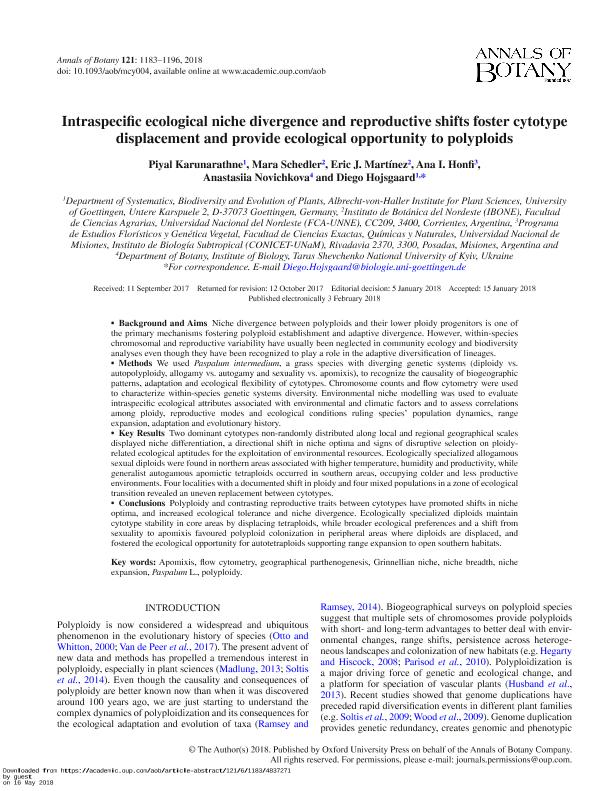Artículo
Intraspecific ecological niche divergence and reproductive shifts foster cytotype displacement and provide ecological opportunity to polyploids
Karunarathne, Piyal; Schedler, Mara ; Martínez, Eric Javier
; Martínez, Eric Javier ; Honfi, Ana Isabel
; Honfi, Ana Isabel ; Novichkova, Anastasiia; Hojsgaard, Diego Hernan
; Novichkova, Anastasiia; Hojsgaard, Diego Hernan
 ; Martínez, Eric Javier
; Martínez, Eric Javier ; Honfi, Ana Isabel
; Honfi, Ana Isabel ; Novichkova, Anastasiia; Hojsgaard, Diego Hernan
; Novichkova, Anastasiia; Hojsgaard, Diego Hernan
Fecha de publicación:
05/2018
Editorial:
Oxford University Press
Revista:
Annals of Botany
ISSN:
0305-7364
e-ISSN:
1095-8290
Idioma:
Inglés
Tipo de recurso:
Artículo publicado
Clasificación temática:
Resumen
Background and Aims Niche divergence between polyploids and their lower ploidy progenitors is one of the primary mechanisms fostering polyploid establishment and adaptive divergence. However, within-species chromosomal and reproductive variability have usually been neglected in community ecology and biodiversity analyses even though they have been recognized to play a role in the adaptive diversification of lineages. Methods We used Paspalum intermedium, a grass species with diverging genetic systems (diploidy vs. autopolyploidy, allogamy vs. autogamy and sexuality vs. apomixis), to recognize the causality of biogeographic patterns, adaptation and ecological flexibility of cytotypes. Chromosome counts and flow cytometry were used to characterize within-species genetic systems diversity. Environmental niche modelling was used to evaluate intraspecific ecological attributes associated with environmental and climatic factors and to assess correlations among ploidy, reproductive modes and ecological conditions ruling species' population dynamics, range expansion, adaptation and evolutionary history. Key Results Two dominant cytotypes non-randomly distributed along local and regional geographical scales displayed niche differentiation, a directional shift in niche optima and signs of disruptive selection on ploidyrelated ecological aptitudes for the exploitation of environmental resources. Ecologically specialized allogamous sexual diploids were found in northern areas associated with higher temperature, humidity and productivity, while generalist autogamous apomictic tetraploids occurred in southern areas, occupying colder and less productive environments. Four localities with a documented shift in ploidy and four mixed populations in a zone of ecological transition revealed an uneven replacement between cytotypes. Conclusions Polyploidy and contrasting reproductive traits between cytotypes have promoted shifts in niche optima, and increased ecological tolerance and niche divergence. Ecologically specialized diploids maintain cytotype stability in core areas by displacing tetraploids, while broader ecological preferences and a shift from sexuality to apomixis favoured polyploid colonization in peripheral areas where diploids are displaced, and fostered the ecological opportunity for autotetraploids supporting range expansion to open southern habitats.
Archivos asociados
Licencia
Identificadores
Colecciones
Articulos(CCT - NORDESTE)
Articulos de CTRO.CIENTIFICO TECNOL.CONICET - NORDESTE
Articulos de CTRO.CIENTIFICO TECNOL.CONICET - NORDESTE
Articulos(IBONE)
Articulos de INST.DE BOTANICA DEL NORDESTE (I)
Articulos de INST.DE BOTANICA DEL NORDESTE (I)
Articulos(IBS)
Articulos de INSTITUTO DE BIOLOGIA SUBTROPICAL
Articulos de INSTITUTO DE BIOLOGIA SUBTROPICAL
Citación
Karunarathne, Piyal; Schedler, Mara; Martínez, Eric Javier; Honfi, Ana Isabel; Novichkova, Anastasiia; et al.; Intraspecific ecological niche divergence and reproductive shifts foster cytotype displacement and provide ecological opportunity to polyploids; Oxford University Press; Annals of Botany; 121; 6; 5-2018; 1183-1196
Compartir
Altmétricas



